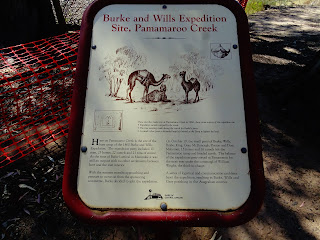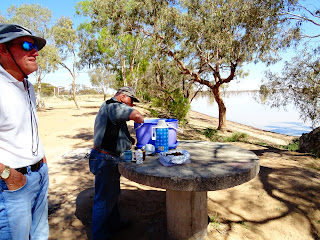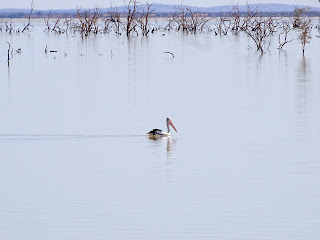Wednesday 16 September
Today we had booked a tour out to Menindee. The lakes system
and Darling River have a chequered history due to drought and man-made
restrictions to water flows. Menindee Lake is dry and is not likely to ever
fill again. This is bad news for those people who have property at Sunset Strip
– Broken Hill’s holiday location on the lake in days gone by – now almost a
ghost town. Indigenous locals would also be feeling the loss of this massive billabong.
 |
| Quick stop at a Burke & Wills camp site |
 |
Map of lakes system
|
 |
| The main weir across the Darling River |
 |
View out across the dry and empty Menindee Lake
|
 |
This thistle flower is now taking over in the area
|
This drawn map shows a little more detail of the area

Copi Hollow is a man-made body of water which was created by
accident when workers on a channel built to siphon water from the Darling River,
created a channel of their own and the lake was created. It is the only lake
which allows water sports.
 |
Copi Hollow, now the main holiday spot
|
Pamamaroo Lake currently has water in it and is kept for
recreational fishing only. Only small boats allowed. Camping is popular along
the banks. We had our morning tea stop her and it was so peaceful.
Wetherill Lake is full and runs up a long way towards
Wilcannia.
So this river and lake (read billabong) system is vast.
We had lunch in the café which serves the town of Menindee.
It was very busy, lots of locals coming and going. Then we headed for Kinchega
National Park to see some of the weirs on the Darling River and the historic
Woolshed. Kinchega was the name of the property which once covered this area,
but it was bequeathed to the National Parks system to preserve the area.
 |
Sadly, the original Maidens Hotel burned down. Burke & Wills stayed here before setting off on their ill-fated trek north
|
 |
More on Burke & Wills
|
 |
Information outside the Maidens Hotel about the expedition
|
 |
Route taken by Burke & Wills north from Menindee between 1860 and 1861
|
 |
| Historic Woolshed in Kinchega National Park |

By 1899 numbers of sheep shorn had dropped from 136,000 to
31,000. A shearer at this woolshed could shear between 60 and 80 sheep in a 10
hour day!
 |
Stalls for the shearers
|
From the Woolshed we visited Weir 32 which was
the first man made weir on the river built to control flow. A chance sighting as we were leaving Kinchega, an emu and three chicks. As we stopped they quickly scuttled off into the scrub.
Our last stop was to visit the place of burial of an Afghan cameleer who was part of the Burke & Wills team. He was fortunate that he was left with the remaining party, who were to await the return of the adventurers. Of course, they never did return. As a Muslim, this Afghan would come to this spot to pray each day and it was here that he was interred as, of course, he was not allowed to be buried in the Christian Cemetery. The headstone is a later addition to the spot.
 |
Weir 32
|
I had made a booking at The Palace Hotel for dinner. Just as well. Many people walked in hoping to eat there but were turned away. This historic hotel was made more famous as the venue for the shows in the film Priscilla, Queen of the Desert. The weekend before we arrived would have been the Broken Heel Festival, held every year, to celebrate diversity in this Outback city. Sadly this is the year of COVID and many such festivals have had to be cancelled. The interior of the foyer is also famous for its murals.
 |
Inside where shows are held
|
 |
The stairway to guest rooms
|
 |
| The main foyer |

































Comments
Post a Comment